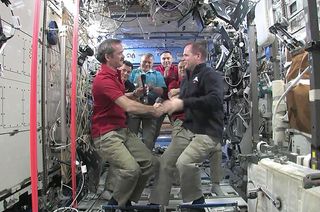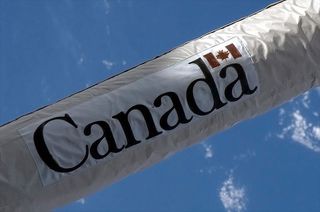Canada in Charge: Astronaut Becomes 1st Canadian Space Station Commander

For the first time in history, a Canadian has taken charge of a space mission.
Chris Hadfield, an astronaut since 1992 with the Canadian Space Agency (CSA), took command of the International Space Station (ISS) on Wednesday (March 13), assuming the lead of the orbiting outpost's 35th expedition crew.
"It is a huge honor and a privilege to me but also for all the people at the Canadian Space Agency ... and for my entire country," Hadfield said from on board the station during a change of command ceremony.
"So, for the International Space Station Program, all the international partners, thank you very much for giving me the keys to the 'family car.' We're going to put some miles on it but we'll bring it back in good shape," he said. [See astronaut Chris Hadfield's amazing space photos]

Hadfield, who is approaching his 100th day on the space station since launching in December, took over command from NASA astronaut Kevin Ford, who led Expedition 34. Ford and cosmonauts Oleg Novitskiy and Evgeny Tarelkin are set to leave the space station to return to Earth aboard a Russian Soyuz spacecraft on Thursday evening (March 14).
"We're very proud of Chris," Ford remarked, after playing a recording of the Canadian national anthem, "O Canada," in Hadfield's honor. "We are very proud of Canada as our partner in this International Space Station. We are really proud most of all that the space station is such a fantastic example of international cooperation."
Canada is one of 15 partner nations that comprise the International Space Station program. As a part of its contribution to the complex, the Canadian Space Agency provided the orbital laboratory's robotic arm, the Canadarm2, as well as a two-armed robot named Dextre, which is also used to move and manipulate items outside the station.
Get the Space.com Newsletter
Breaking space news, the latest updates on rocket launches, skywatching events and more!
Hadfield, along with NASA astronaut Tom Marshburn and cosmonaut Roman Romanenko are scheduled to stay on the space station through May. They will be joined later this month by three new Expedition 35 crew members, including Chris Cassidy of NASA and cosmonauts Pavel Vinogradov and Aleksandr Misurkin, both with Roscosmos.
This is not the first time that Chris Hadfield has made Canadian history. In addition to his new role as the first Canadian space commander, Hadfield earlier set the record as the first Canadian to walk in space in 2001 and was the first of his countrymen to visit the International Space Station on that same mission 12 years ago.
"He's a uniquely talented person on the planet and now a uniquely talented person off the planet," said Ford.
Commanding the world's spaceship
In a pre-flight interview with collectSPACE.com, Hadfield described his taking command of the space station as a "watershed moment" for Canada while also acknowledging his crew's place in the orbiting laboratory's history.
"I am the commander of Expedition 35. I mean, 35 is a big number, it is not like we're going to revolutionize the world. We are not taking the first steps on the moon," Hadfield told collectSPACE. "But for Canada, this is a very visible and tangible measure of accomplishment that has been a long time coming and hard earned."
"It is rare, in fact, it is a brand new, unprecedented thing for Canada to be able to command what is in essence the world's spaceship," Hadfield said. [Canadian Astronaut's 1st Song from Space (Video)]
This year marks the 50th anniversary since the launch of Alouette, Canada's first satellite in space, and it has been 29 years since astronaut Marc Garneau became the first Canadian to orbit the Earth.
"I stand on the shoulders of so many that have made this possible, and now take my turn to try and add to that solid foundation for the Canadians that follow," Hadfield said in a statement after becoming Expedition 35 commander.

Hadfield's rise to command the station was recognized in statements released by Canada's Prime Minister Stephen Harper and by the Queen of England Elizabeth II.
"Today, on behalf of all my fellow citizens, I would like to congratulate our very own space pioneer, Chris Hadfield, who is continuing in that fine tradition of pushing the limits by being named the first Canadian to take command of the International Space Station," Harper said.
Hadfield is not a stranger to being hailed on the national level. His likeness has appeared on Canadian stamps and coins, and schools, roads and an airport have been named after him.
"It's a tremendous honor to be on a stamp for the country, or to have my face on one side of a coin and the Queen on the other," Hadfield told collectSPACE. "To be at that level is a little bit of a giddy-feeling but at the same time, it is very surreal and mostly is just a palpable and tangible measure of hopefully a life well lived."
The dawn of Expedition 35
As Expedition 35 begins on board the space station — a moment marked when the prior crew departs for Earth — Hadfield and his shipmates will adopt a new mission patch to signify the transition.
Hadfield sought the assistance of another Canadian, artist and writer Paul Fjeld, to come up with the design for the Expedition 35 crew emblem.
The oval-shaped insignia portrays a natural moonlit view of the Earth as seen from the station at the moment of an orbital sunrise.
"We all agreed we wanted it to be simple and expressive, inherently beautiful and we didn't needed our names on it," Hadfield described. "The purpose of the patch was not to advertise who we were but instead to try to capture the essence of this particular part of space exploration."
According to the crew, the emblem's depiction of the arc of the Earth's horizon with the sun's arrows of light was to symbolize "a bow shooting the imagination to Mars and the cosmos where our species may one day thrive."
"[The patch] puts together the beauty of the big mother Earth below us and where we are heading, with the moon and Mars," Hadfield said. "It puts it all into the context of the wonderful endlessness of space with the things that we don't know yet."
Follow collectSPACE on Facebook and on Twitter at @collectSPACE. Copyright 2013 collectSPACE.com. All rights reserved.
Join our Space Forums to keep talking space on the latest missions, night sky and more! And if you have a news tip, correction or comment, let us know at: community@space.com.

Robert Pearlman is a space historian, journalist and the founder and editor of collectSPACE.com, an online publication and community devoted to space history with a particular focus on how and where space exploration intersects with pop culture. Pearlman is also a contributing writer for Space.com and co-author of "Space Stations: The Art, Science, and Reality of Working in Space” published by Smithsonian Books in 2018. He previously developed online content for the National Space Society and Apollo 11 moonwalker Buzz Aldrin, helped establish the space tourism company Space Adventures and currently serves on the History Committee of the American Astronautical Society, the advisory committee for The Mars Generation and leadership board of For All Moonkind. In 2009, he was inducted into the U.S. Space Camp Hall of Fame in Huntsville, Alabama. In 2021, he was honored by the American Astronautical Society with the Ordway Award for Sustained Excellence in Spaceflight History.

